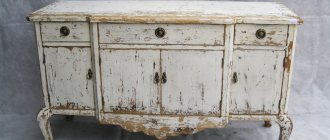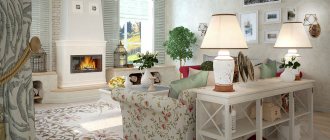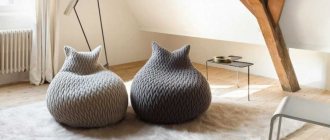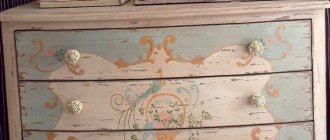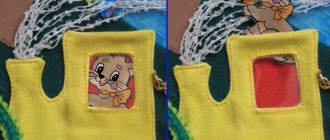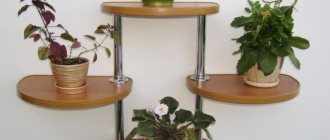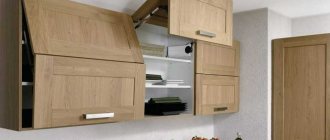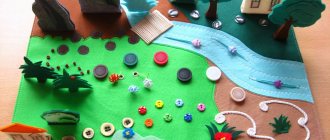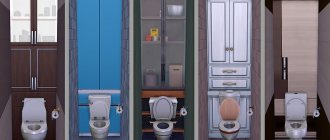Vintage interiors envelop you with special energy, homely warmth, and ease, so interest in them does not fade for years. Today, the designers of the Dekorin project will show you how to make furniture in the Provence style with your own hands. After scrolling through the photos, you will see that you don’t have to be a pro to make amazing decor. The main thing is to be patient (it may take more than one day) and use your imagination.
Types of technology
Decoupage can be done in different ways and using different materials: all kinds of paints, specific varnishes, as well as napkins, textiles, wallpaper and even eggshells.
Decoupage is a surface decoration technique that imitates artistic painting.
The most popular method of decorating furniture is using crackle varnish. It is applied to the surface in a thick layer, and sometimes in several layers. And as it dries, cracks appear, reminiscent of the surface of antique interior items. Thanks to this feature, tables, cabinets and chests of drawers fit perfectly into the Provence style.
Ease of execution allows even people without artistic skills to turn any interior item into a work of art.
There are other ways to artificially age furniture:
- Mechanical impact. Using various tools, cuts, cracks and scratches are made on the surface. An important nuance: before starting work, you should make a diagram of the expected “damage”, otherwise it will be clear that the furniture is new, but damaged, and this is a completely unsuitable option for the style.
- Chemical reactions. Chemicals are applied to the surface that can “corrode” wooden furniture. Vinegar and ammonia are most often used; with their help, you can seriously change the appearance of interior items.
- Thermal impact. High temperature and sometimes open fire are used; in some cases, furniture is exposed to a special blowtorch. If you choose this method, be very careful not to harm your health or damage the furniture.
- Numerous liquid products. They are applied with brushes, rollers, sponges or spray, depending on what effect you want to achieve as a result.
For decoration, lace, paper napkins, and fabrics are used, which can be used to decorate any surface.
It is thanks to the decoupage technique that you have the opportunity to radically change the appearance of furniture, make it unique in its kind, and complement a typical piece of furniture with elegant designs and ornaments.
Modern craftsmen combine various techniques and materials in their works to decorate objects.
Before you start work, you should think in advance about what exactly and how you will use for decoration. And also prepare the surfaces in the proper way.
Design
The popularity of using wall painting in a modern interior does not mean that the choice of subject and execution technique can be dictated by the lack of skills of the home craftsman or his personal preferences. Each of the common options has a purpose.
Black and white graphics will easily fit into a loft, but will be out of place in an empire style. The image of a black mountain with a white cap of snow, a stylized Japanese landscape look great in the Japanese style. A creative picture of the night with a lantern, an impressive mural are suitable for the living room, and a map of the world is suitable for the nursery.
There are standard stereotypes that you can easily move away from by painting a shimmering space or a tempting sea on your bedroom wall to wake up in a good mood. But tropical leaves should not be in the Provence style, nor in the Empire style, nor in the traditional classical style, just as the tree should not be in the ultra-modern style, which is characterized by metal and stone.
Art for Beginners
After the preparatory stage, they proceed directly to the design of the furniture.
Using stencils
Painting with a stencil is the easiest way to transform the interior of a room. Having chosen the option you like from numerous examples, it is initially printed and then transferred to a thick sheet. The ornament or other image is carefully cut out. Simple and at the same time attractive patterns are presented below:
The surface of the furniture is initially painted with a background color; usually, calm shades are chosen for these purposes. After the paint has dried, the stencil is securely fixed to the furniture and the prepared cutouts are filled with brighter paint. The work is carried out with a sponge, so the surface is painted more evenly. It is better to gradually apply several layers to the furniture.
Depending on the chosen pattern, furniture painting can be done in one color or multi-color. In conclusion, it is recommended to additionally outline the outline of the painting to obtain a brighter image. If the stencil is small, you can use the pattern on several objects, the main thing is to observe moderation to avoid oversaturation of the interior with bright colors.
Decoupage technology
The essence of the decoupage technique is to attach a design made on paper or fabric to a dense base. These can be small vases and jars or larger furniture. The advantage of decoupage compared to painting with acrylic paints is that you don’t have to choose a wooden surface for decoration.
The choice of varnish is of great importance when preparing materials. Depending on the composition, the surface of the furniture can be:
- semi-matte;
- matte;
- with sparkles;
- semi-antique;
- semi-gloss;
- glossy.
To imitate painting, a special material with a pattern is purchased. There are the following options for furniture decor:
- Napkins. Due to the thin base, they are quite difficult to work with. It is better for beginners to practice on small, flat surfaces of furniture.
- Decoupage card printed on rice paper. Due to the denser base and elasticity, achieving the effect of painting on furniture will be a little easier.
- Decoupage cards on plain paper.
- Prints on photo paper. The advantage of the solution is the ability to order any image that is optimal for decorating furniture.
Attention! Regardless of the chosen pattern, the section of furniture intended for painting using the decoupage technique is painted with a white background. The reason for the requirement is simple - before application, the paper with the pattern is moistened; if the base is colored, the color of the painting will be noticeably distorted
On a white background, the color scheme will remain in its original form.
The drawing is fixed in different ways. Usually the surface is treated with glue, after drying, paper with a pattern is applied and carefully leveled, ensuring the complete absence of bubbles or wrinkles. When the paper dries, the drawing is coated with varnish, which will preserve the integrity of the painting.
Illustrative examples of painting done using the decoupage technique are presented in the photo:
Bathroom
Tired plain tiles in the bathroom and toilet can be updated by painting the walls yourself. For this:
- Wash the tiles thoroughly using Pemolux or another detergent.
- The tiles are sanded with fine sandpaper, creating roughness to enhance adhesion.
- Wash off dust and prime.
- The design is applied over squares using special paints.
If space allows, you can create a 3D drawing at the bottom of the bathroom.
Painting walls in a home is a relevant element of decor, it gives the room individuality, adjusts the dimensions and shows the taste of the owner
The drawing attracts the attention of guests and adds pride to the performer in his work.
https://youtube.com/watch?v=y_ervzcCgvc
Concepts for decorating in the Provençal version
Don’t delay, try now to take some object inherited from your ancestors - an armchair, a table, a chair or a chest of drawers, and use several available methods yourself. If desired, decorating Provence is not so difficult. To process a product and create artificial aging, you must first prepare it; remove all removable elements, drawers and shelves.
Don’t delay, try now to take some object inherited from your ancestors - an armchair, a table, a chair or a chest of drawers, and use several available methods yourself. If desired, decorating Provence is not so difficult. To process a product and create artificial aging, you must first prepare it; remove all removable elements, drawers and shelves.
Let's look at several available techniques and concepts for aging furniture at home:
- Using paraffin and coloring materials, for this we need to have the following materials and tools on hand (pastel shades of paint, sponge, fine-grained sandpaper, wax and a chair):
- Lay paper or film on the floor to avoid contamination.
- If there is paint or varnish on the item, remove it with fine-grit sandpaper.
- then the entire surface must be thoroughly rubbed with wax parallel to the growth of the wood fibers.
- then start painting using paint in an aerosol can, as it is more convenient for painting cracks and other hard-to-reach places, hold the can at a distance of about 50-60 cm from the chair and apply the paint in a thin layer for an even coating.
- to give the effect of aging, you need to use a sponge to gradually wipe off the paint and wax, but don’t be too zealous, because in the end you can erase too much and it won’t look very nice.
- If you wish, you can apply drawings typical of Provence painting onto the resulting surface.
- To consolidate the resulting effect, cover the entire surface of the piece of furniture with 2-3 layers of varnish, you can use craquelure varnish to create as many cracks as possible.
It will be much more convenient to work with paint in a spray can.
- Steel wool of black-gray color (steel wool), it is used for grouting and polishing furniture, you can buy it in construction stores:
- Let's take an old chair again, prepare it for decoration by removing all removable elements, then use fine-grained sandpaper to remove a layer of old varnish or paint and paint it with one or more similar shades of paint.
- parallel to the growth of the fibers, let’s go through “steel wool”, using it very intensively and confidently, as a result the entire surface will be covered with a layer of black soot, take a damp cloth and wipe the piece of furniture, achieve the desired effect of antiquity, i.e. give slightly noticeable worn and dilapidated marks Provence, then go over the entire surface with a dry cloth.
- We fix the resulting surface with 2-3 layers of varnish.
Decoupage in old French design with your own hands, for this you need to have the following materials and tools (fine-grained sandpaper, acrylic white or pastel paint, napkins with images of Provence, scissors, glue, sponge, acrylic varnish, powder to create a patina effect): prepare the surface (again Let’s take a chair as an example), after removing any remaining varnish or paint from it, apply acrylic paint in 2-3 layers. cut out the selected Provençal style of design, glue it to the selected place, and carefully wipe off the remaining glue with a sponge. When the image is dry, being careful, we sand around the drawing to ensure that the paint is rubbed off. Apply acrylic varnish and then powder to create a patina effect in some places (no need to cover the entire surface). We fix the resulting Provence effect with 2-3 layers of varnish.
Well, we have learned how to do the aging of interior items in Old French design with our own hands. We hope that everything we have written here will help you create elegant and unique furniture products in the Provençal style and make your home cozy and comfortable. However, to achieve uniformity in design, use various decorative items (figurines, vases, lamps, sconces) in a rustic or nautical style.
Mosaic
Mosaic on the kitchen wall looks very appropriate and aesthetically pleasing. This finishing method allows you to restore, creating many original color and texture variations that are suitable specifically for your interior. In addition, mosaic tiles are durable and moisture-resistant material.
Mosaic on the wall is a way to transform an old kitchen.
There is a wide variety of mosaic tile options, we list the main ones:
- Ceramic mosaic. It is durable and strong, easy to maintain and environmentally friendly.
- Glass panel. Glass tiles are also highly resistant to moisture and chemical compounds.
- Plastic mosaic. This type of PVC mosaic is easy to install on your own, as the panels can be easily separated using scissors or a utility knife. Its advantages are low price and easy replacement. You can make any design from this mosaic, choosing colors that suit your interior. The disadvantages of this material include susceptibility to deformation.
- Tiles imitating mosaic. It is a tile consisting of smaller squares.
- Mosaic made of broken tiles. This option looks very original and is cheaper in cost than whole tiles. In addition, you can prepare broken tiles yourself.
How to create a mosaic pattern with your own hands
There are many technologies for creating a mosaic pattern - from the simplest, geometric, to those using a computer, which even allow you to create a reproduction of an artist’s masterpiece. The geometric method involves simply alternating squares of different colors with different sequences. You can find out about PVC apron here.
The computer can also be used for the geometric method. On the Internet you can find free special programs for color selection and determine those color combinations that will look most aesthetically pleasing in your interior.
There are also ready-made mosaic modules; the choice of patterns is quite wide and satisfies any needs. The technology for laying such mosaics has been significantly simplified.
To create a mosaic panel, special matrices and mosaic grids are used. The squares are glued to the frame and a tile of a certain size is obtained. Find out how to transform an old table with a ceramic tabletop in this material.
Mosaic laying
The mosaic installation process consists of the following steps:
1. Preparatory work. The surface on which the mosaic matrix will be applied is carefully leveled and primed
It is very important that the surface is well cleaned and dry
2. Surface marking. The matrix sheets should be laid out on the floor according to the drawing and measurements should be taken. Then control marks are placed on the wall in accordance with the measurements.
3. Apply glue solution to the surface. After this, the actual installation begins. The glue does not need to be applied to the entire surface at once, otherwise it will dry before the entire mosaic matrix is applied. The matrices are laid and after the final adjustment of the sheets to each other, they are firmly pressed into the adhesive solution.
4. Grout. After you are sure that the solution has completely hardened, remove the protective layer from the mosaic after soaking it. Do not wait for the grout to dry, as this will make the grout difficult to remove.
Bedroom in Provence style
The decoration of the rest room warms and soothes with warm, delicate shades. An unobtrusive floral pattern on wallpaper looks great. In this case, a combination of finishes is allowed, for example, one of the walls is painted, covered with wood or decorated with paintings. The ceiling is traditionally smooth and white.
A vintage forged model with simple, smoothly curved outlines would also be a good choice. A rug near the bed keeps your bare feet warm.
A light canopy, creating a feeling of airiness, and lace bed linen, decorated with hand embroidery, perfectly convey the romanticism of Provence.
In addition to the bed, furniture in a Provençal bedroom usually includes wooden or forged upholstered armchairs and rattan wicker chairs, banquettes, bedside tables on thin legs, an antique dressing table, a chest of drawers or a wardrobe.
Decorative pillows, rugs, bedspreads, and other various textiles soften the interior and bring coziness, which is so necessary in this room. The upholstery of upholstered furniture is printed, made of natural coarse fabric or cashmere.
Curtains with all kinds of frills, flounces and ruffles protect from sunlight and decorate the window. The color palette of curtains, wallpaper, upholstery, linen and other decorative elements must be completely or partially identical.
The main chandelier is usually installed in the center of the ceiling, with glass shades on forged holders or a dense fabric lampshade with fringe. Quieter light, suitable for night reading, is provided by shaped table lamps on bedside tables, sconces or floor lamps.
A fireplace is often found in a French bedroom. A natural or artificial hearth will undoubtedly add coziness, help relieve stress and distract from anxious thoughts.
Cute little things like flower vases or animal figurines bring life to a room. Engravings with wooden frames depicting rural landscapes or flowers serve as appropriate wall decorations. Mirrors in an elegant frame help create a special intimate atmosphere.
Features of the Provence style
Provence is a more sophisticated analogue of American country. The style of the French countryside is distinguished by both simplicity and sophistication, elegance and modesty, an affinity for vintage furniture, naivety and idyllic tranquility. It is sincere and cozy, like a grandmother’s village house from childhood memories. It is especially common in kitchens, but can also decorate other rooms: living rooms, dining rooms, bedrooms.
Rare or antique furniture is very elegant and beautiful, but not everyone can afford this pleasure.
Style Features:
- Antique or artificially aged furniture.
- Natural flowers.
- Decoration with floral and rustic ornaments.
- An abundance of things from the “good old days,” from grandma’s box to antique trinkets bought at a flea market.
- Decoupage, sewing, ruffles and other handmade decor, made with your own hands.
- Softness, naturalness and variety of materials.
Before you start aging furniture on your own, it is necessary to thoroughly prepare all wooden surfaces that will be processed.
What furniture is best to use on?
Of course, there are no restrictions on the choice of subjects. The main factor determining suitability is the material. To implement the plan, old furniture made of wood is better suited. This is precisely where its value lies relative to modern products made from chipboard and fiberboard. “Sawdust furniture” is definitely not suitable.
A wooden surface is easier to work with. Old paint or varnish can be easily removed, various defects (chips, cracks) can be eliminated or left to give an “aging” effect. In addition, most methods of applying patterns are designed specifically for wood. Any pattern or ornament looks good under varnish on wood texture. Furniture covered with natural veneer is suitable. An example of this is an old wardrobe or chest of drawers made of multi-layer veneered plywood. After removing the old varnish or paint, the surface is primed, painted in the required color and a design is applied.
But furniture made from modern materials should not be crossed off the list. MDF facades coated with acrylic can be painted in any style after certain preparation. Acrylic coating is a layer of paint that is polished after drying. This type of coating is often used in the manufacture of kitchen facades.
Stencil painting
You can decorate your walls using stencil painting. Even a beginner can master this type of composition application. All you need is a high-quality template. Step-by-step master class:
The original picture found on the Internet must be printed and sent to a photo workshop for enlargement and making a stencil. The latter can be done with your own hands, with time, perseverance and accuracy. A stencil is applied to the prepared and grease-free wall, carefully attached tightly with tape, preventing the film from leaving the surface. Then you can paint it in different ways: by hand or from a spray can. In the first option, use a roller or sponge (they are convenient for filling in the design)
The second requires care, as there is a possibility of paint leaking down. Without waiting for it to dry, remove the stencil and carefully touch up the unpainted areas with a brush. After this, the work is covered with several layers of varnish to protect it from abrasion.
A small ornament can go along the entire perimeter of the room, but it is advisable to use a large ornament only on one wall so that there is no overload. For lovers of minimalism, a monochrome black and white pattern is suitable.
Designers advise taking the simple route. To obtain an ornamental motif, it is easier to use, for example, when decorating a dacha, the decoupage technique. The pattern can be placed around the perimeter of the ceiling and covered with waterproof varnish.
How to decorate a closet
To decorate your closet in a “rustic” French style, you will need to do the following:
Use fine-grit sandpaper to remove old paint and varnish. Apply light acrylic paint in several layers (base – white, then beige or another pastel shade). Select and cut out a motif for decoupage from a napkin. Glue the image with a glue stick or PVA glue. Remove excess glue by gently dabbing the image with a kitchen sponge. Let the cabinet dry. Gently rub with sandpaper in several places adjacent to the image, achieving the visual effect of slight abrasion of the paint. Cover the cabinet with acrylic varnish. Apply patination powder in randomly selected places. Cover the cabinet with 2-3 layers of varnish.
Rice. 3. A double-leaf wardrobe with drawers is made in light milky gray shades, the effect of slight wear and patination can be seen. The charm of Provence is additionally conveyed by the image of a flower arrangement on the doors.
The work will go smoothly if before you start you make sure you have at hand:
- three-layer napkins with a pattern corresponding to the Provence style (focus on the rural landscape, images of domestic animals, still lifes, various floral arrangements, plant motifs);
- quick-drying acrylic paints (you can get by with just one);
- fine grain sandpaper;
- glue stick or PVA glue;
- kitchen sponge for washing dishes;
- patination powders;
- acrylic varnish;
- scissors
Old chest of drawers in Provence style
Let's consider all the subtleties of transforming ordinary interior items into exclusive designer items. For example, let's create a chest of drawers in Provence style. To do this you will need the following tools:
- brushes;
- rags;
- sandpaper;
- steel wool;
- dye.
We paint the chest of drawers in several stages:
- First, you should sand the wooden surface with sandpaper. This must be done in order to remove old varnish or paint. To sand the surface, use coarse-grain paper first, then fine-grain paper.
- Now you can start painting the chest of drawers. When choosing paint, remember that the Provence style is characterized by warm pastel colors. Therefore, choose a paint that is beige or light gray in color. Using a brush, carefully paint the entire surface, as well as the inner walls.
- When the paint has dried, use charcoal-colored steel wool to cover the entire surface. After such manipulations, dark lines will appear on the chest of drawers. Wipe them with a wet cloth until the lines turn light gray. This technique will allow you to effectively age furniture in the Provence style with your own hands. Now you need to wipe the surface with a dry cloth.
- Paint all handles with the same paint as all the furniture. When dry, scrub them thoroughly with a steel brush and dry with a rag. Now the fittings match the main style of the chest of drawers.
- The bottom of the drawers can be decorated with fabric with a floral print. The main thing is that the textile color matches the main tone of the chest of drawers.
Graffiti
One of the types of airbrushing is graffiti. This trend in wall painting appeared in the 80s, when teenagers painted the facades of buildings on city streets, the walls of garages, and this action was regarded as hooliganism. Translated from Italian it means “drawings written or scratched with paint.” At the moment, it is very popular in the design of loft-style homes, where there are elements of brickwork.
Using this type of wall decoration, a person with the help of graffiti:
- emphasizes the individuality of your home;
- visually enlarges the room;
- compensates for the lack of furniture thanks to bright elements;
- corrects room imperfections.
There are several ways to design using this technique. You can do the following:
- draw a sketch on the wall and paint on it using brushes and a roller;
- use a stencil (usually for letters) and add some elements with spray paints;
- glue ready-made graffiti and complement them with painting;
- apply a design from a spray can without using tools.
Abstraction and depiction of space are appropriate in this type of technique.
Interior furnishings in the old French style
For decoration in Old French design, surfaces made of natural wooden materials with the addition of forged iron elements are usually used. Modern interior items made from innovative materials (chrome, nickel, aluminum, glass furniture, etc.) do not fit into this atmosphere at all, but even artificial materials like wood are perfect for painting furniture with a unique style Provençal province, painted in delicate pastel shades.
A wicker chair, a forged cornice, furniture with intricate ornaments and ornate motifs, in general, anything that contains a touch of antiquity, a grandmother’s wooden chair, a chest of drawers, a bed or a chest, fit perfectly into such an atmosphere, proving with all its appearance that it has served for more than one generation. In principle, it is possible to apply this style in all rooms of your home; the most important thing is to have the necessary items on hand and learn how to age them with your own hands.
Read a separate article on how to paint a chair.
Decorating any room using this method will combine comfort and ease of use.
Specifically, the Provence style brings associations not only with the classic French village, but also with a place to relax.
The simplest technologies
To carry out wall painting in the kitchen, you can choose a technique that is suitable in terms of the level of complexity and availability of materials for almost anyone who wants to do the painting with their own hands.
For wallpaper to be painted
It’s not difficult to make a drawing on the wall yourself, but the basis for applying the drawing - in this case, wallpaper - must be of high quality
An excellent option for this is paintable wallpaper, no matter whether it is white or colored. White wallpaper can always be painted in a color that suits you
After pasting the wall on which the painting is applied, the glued wallpaper is painted with the desired color (for example, dark brown), then a design is applied over the dried paint. Take your time and wait about a week to allow the paint on the wallpaper to dry thoroughly before applying the design.
What to draw with?
You may find it more convenient to apply a design to the wallpaper using a so-called textured roller. The textured roller is made up of two: a roller with a pattern and a regular rubber one. The technology of work is simple and very similar to painting, but, nevertheless, it is better to first practice on an unnecessary piece of wallpaper. The image shows the technique of applying a pattern using a textured roller. This technology is especially convenient when applying a floral or geometric pattern to wallpaper. Remember that before applying a geometric pattern, you should mark the walls for it.
Stencil
Stencil painting is quite accessible both in terms of technique and materials. Drawing with a stencil does not require any special skills or costs: you can take the risk of painting even without special education. But in any case, the kitchen walls on which the painting is supposed to be painted must also be prepared. Tools can also be the most common ones used for repairs: roller, brushes, sponge. It is best to use acrylic paints for stencil painting; they adhere perfectly to the surface, are non-toxic and durable. You can use acrylic paste or fine-grained plaster.
But when choosing from a huge number of available stencils, your individuality and the presence of a clear vision of how your kitchen will look should be reflected. Stencils can be bought in many construction or online stores, but it’s more interesting to make them yourself. It is most convenient to work with stencils made of polymer film that can be glued to the wall: they are easy to clean and reusable.
Another way to paint kitchen walls with your own hands is to use stamps
It is important that the image on the stamp is clear. Stamps can be made of foam sponge, cork or other natural material: in construction stores you will find a wide selection for drawings
Don’t be afraid to spend time thinking about the composition, how well the painting you choose conveys your idea, and how individual elements do not discord with each other and with the kitchen design style as a whole. And don’t forget that painting can immediately transform the kitchen, but it can also ruin it, quickly get boring and become an irritating element for some family members.
How to make it from scrap materials?
The distinctive features of furniture in the Provence style are soft and delicate colors, ranging from milky to turquoise or lavender, laconic forms, and rustic simplicity. Furniture items must have an aged appearance. There are scratches, small cracks, and chips on the facades. The color of objects should be blurred and muted, as if faded under the scorching southern sun.
Do-it-yourself bedside table in Provence style, watch in this video.
In fact, making furniture in the Provence style with your own hands is not so difficult. Especially if natural wood is used as the main material. Almost every man is familiar with the basics of carpentry and is able to make furniture blanks using ready-made templates. To work with wood you will need the simplest tools:
- screwdriver;
- wood hacksaw;
- sander;
- milling cutter;
- electric jigsaw.
Materials that will be useful in the work process:
- tree;
- brushes and rollers;
- paints and varnishes;
- fastening elements;
- sandpaper.
As for forged furniture, the situation here is somewhat different. To make it, you must have a welding machine and know how to use it. Forged elements and decors can be purchased ready-made in the store and you can decorate your bed, coffee table or banquette with them yourself. The metal is coated with white paint and sanded with fine-grained sandpaper to give it an antique effect.
You can make the following furniture items with your own hands in Provence style:
Wardrobes. They are made tall, massive and with two or three doors. Their facades are decorated with carvings and painted in delicate colors.
Dressers. They are available in different colors, ranging from white, blue, and ending with pink. Dressers can be either elegant or large in size. They have original curved legs, worn surfaces, and are often locked with padlocks.
Sofas. They embody good quality, softness, comfort and beauty. Their upholstery can be plain or with floral patterns. The main thing is that it is made of rough and natural fabric
A large number of decorative pillows made of linen, cotton or burlap must be placed on top of the sofa.
Beds They are given special attention, as they occupy an important place in the bedroom. The materials used to make beds are wood or metal. The products are distinguished by their impressive size, some roughness and snow-white colors
Near the bed there are bedside tables on which forged lamps are installed.
Near the bed there are bedside tables on which forged lamps are installed.
Leaf ATTENTION: in the Provence style the use of glossy surfaces is not allowed. All furniture items are distinguished by their strict shapes and aged appearance. The main stylistic features of furniture in the Provence style are:
The main stylistic features of furniture in the Provence style are:
- presence of carved components. Here it is worth considering that not everyone can make carved facades on their own. In this case, you can buy carved legs, sides, handles and the like in stores;
- decorative carnations that give the furniture an antique look;
- decorative painting on facades. To do this, pale and slightly faded floral motifs or other compositions are applied;
- use of copper and bronze handles and other accessories.
Line Chart IMPORTANT: when making furniture in a rustic style, the use of modern materials such as laminated chipboard, MDF or PVC is not allowed. The main thing is that when making furniture in the Provence style with your own hands, do not be afraid to experiment in order to make interesting changes to the provincial interior. The main thing is that when making furniture in the Provence style with your own hands, do not be afraid to experiment in order to make interesting changes to the provincial interior
The main thing is that when making furniture in the Provence style with your own hands, do not be afraid to experiment in order to make interesting changes to the provincial interior.
Maybe,
My “kitchen” wall paintings
painting in the kitchen with abstraction in the process of painting
painting the wall in the kitchen with acrylic paint in finished form
More details of this painting and fragments can be seen on the page 3d drawing in the kitchen.
painting the walls in the kitchen with Venice
Artist in the kitchen near the completed wall painting
kitchen walls before and after painting
painting the walls in the kitchen behind the bar counter in Moscow
In this kitchen in Moscow, I painted almost all the walls), but this wall turned out to be the most saturated, on the other walls there are elements: small shelves, cats, still lifes... If anyone is interested in seeing this painting in its entirety and in detail, go to the page Painting the wall behind the bar counter.
painting walls in the kitchen with catsI didn’t make a separate page for this painting, since it’s very small, but I collected all the cats on the cats on the walls page, so if you’re interested in cats, go check it out)
unusual painting in the kitchen with a fountain
painting the kitchen walls with a tree and birds
kitchen apron painting
painting kitchen walls in Provence style with a cat, bottles of wine, a bird and a mouse
Well, this is perhaps my most famous wall painting, which everyone has already copied many times) go to the page with it - painting kitchen walls in Provence style.
Monet painting on the kitchen wall
Painting a pillar in the kitchen intended for a refrigerator
The kitchen is being painted, all that remains is to finish the stones around the windows. But in the unfinished painting you can see that the stones have a relief shape, I sometimes do this with putty before painting if they won’t walk along the wall and cling.
kitchen with landscape and cat on the wall
Furniture decor
Furniture in the Provencal country style is simple and devoid of bulky elements. Wooden furniture can be decorated with forged parts that organically complement the noble natural material.
But the main feature of furniture in the spirit of Provence is its age. Antiquity or imitation of many years of use remains the main requirement for a headset.
How to age furniture
You can artificially age wooden furniture using paints, stains and brushing techniques. The last method involves removing soft wood fibers with special metal brushes. After this treatment, the surface is covered with colorful wormholes. Such furniture can be additionally coated with paint or varnish.
To age furniture with paint you will need:
- at least two shades of water-based paint;
- wood stripping tools;
- sandpaper and brushes;
- varnish
Wood processing takes place in several stages.
- Disassemble the product and unscrew all accessories from it;
- Remove old varnish and paint;
- On a clean, dry surface, apply a shade of paint that will not be dominant;
- After the first layer has dried, paint the wood with a base shade;
- After the second layer of coating has dried, treat the furniture with sandpaper, carefully sanding those areas that should look vintage;
- After this, remove dust and paint residues and cover the surface with a layer of varnish.
Upholstered furniture is also suitable for artificial aging. It is quite simple to alter it by choosing unevenly colored leather and any other materials for the upholstery that imitate the long service life of the headset.
Furniture painting and painting
Acrylic paints are suitable for painting and painting furniture. To breathe new life into an old piece of furniture, you don’t have to have the talent of an artist, because you can apply an elegant floral pattern in the Provencal style using a stencil.
- If necessary, treat large chips with wood putty. To maintain the vintage appearance, this preparation step can be skipped;
- Use fine sandpaper to sand the entire surface of the headset. This is necessary to create a rough layer that will fully absorb the primer;
- Degrease the surface of the furniture and apply a layer of acrylic primer;
- After it has dried, apply acrylic paint with a roller, the shade of which will serve as the main background of the product. To get an interesting texture, apply paint with a narrow brush, making strokes at different angles;
- After the base color has dried, apply the desired pattern to the furniture and cover the product with two layers of yacht varnish.
Decoupage in Provencal style
Decoupage remains one of the most popular techniques for decorating interior items among fans of vintage motifs. With its help, you can decorate both a miniature wooden box in the Provence style and large furniture, which will become a harmonious component of the interior in the country style of medieval France.
There are several decoupage techniques for artificially aging furniture.
- Coating furniture with a special craquelure varnish imitates a refined patina effect on the surface;
- A variety of decoupage powders allow you to create soft shadows. This technique will help those who plan to immortalize various images or even photos on a wooden surface;
- Special pastes and gels, tools and stencils make it possible to play with textures, giving areas a special relief and patterned texture;
- Gilding with acrylic or spray paint allows you to give the item a slight sophistication that will not deprive the interior of its simplicity and unobtrusiveness.
Decoupage technique on large surfaces using plastic film
Transferring elements of decoupage napkins to large surfaces often causes difficulties even for experienced craftsmen. A large piece of paper may not wrinkle aesthetically, which significantly reduces the decorative effect of the product.
But to overcome these difficulties, there is a little trick that allows you to easily move the napkin using film. Even a stationery file or a large package is suitable for these purposes:
- After all the preparatory work, cut a piece of polyethylene corresponding to the size of the transferred element;
- Peel off the top layer of the napkin and place it face down on the plastic;
- Moisten the napkin with water and, if necessary, straighten it with a brush.
- Taking a piece of polyethylene by the corners, place the damp cloth on the surface to be decorated.
- Gently smooth the paper through the film.
Preparing the wall for interior painting
This is an important point at the initial stage of wall decoration. With proper and high-quality preparation of the surface, the durability and durability of the image are guaranteed. If mistakes were made at this stage of the repair, the image may soon:
- crack;
- peel off along with the putty and crumble;
- change color
Good quality is guaranteed by the invited artist. However, if you follow the order of the steps and do not deviate from the instructions, you can cope with this difficult task on your own. Tools needed for finishing:
- bucket;
- brushes and roller;
- metal spatulas of different sizes;
- drill;
- sandpaper;
- iron brush;
- building level.
You will also need plaster, various types of finishing putty, and deep penetration acrylic primer.
Preparation technology:
- You need to start by cleaning the surfaces from old plaster, wallpaper, paint, removing unevenness and defects. If the partitions are new and smooth, then spatulas and a metal brush are enough for the job. A sander may come in handy (when removing multiple covering layers from an old wall). If you have problems removing old paint, you can use solvents (white spirit, acetone) and alkaline detergents. At the same stage, it is necessary to treat the walls with antifungal agents, especially for the bathtub and toilet.
- An important and necessary step is leveling the plane for creativity. Check the partition using a building level and apply a deep penetration primer with a brush or roller. Wait for it to dry completely.
- Plasterboard wall panels are puttied only at the joints of sheets and fasteners. Irregularities less than 5 mm are removed using putty, which is applied in small layers in several stages, while it must be taken into account that dry and wet rooms will require different types of building material.
- For deeper defects, the walls are plastered in several stages to avoid future cracking.
- Next, apply finishing putty, completely clean the partitions with sandpaper, and remove dust from chalk and plaster.
- The prepared surface is treated with an acrylic primer (it strengthens and adds adhesive properties). If the walls have high humidity, then the coating is made with a product that has moisture-repellent properties.
Any mistakes made at this stage can be revealed during painting, so it is necessary to carefully prepare the room for painting.
With the help of decorative Venetian plaster, surfaces are given a beautiful look of natural or precious stone or wood. This technique looks great in an interior stylized as minimalism, as well as in classical styles, such as Baroque and Art Nouveau. Using templates, you can apply stylized images of lilies on top of the plaster.
